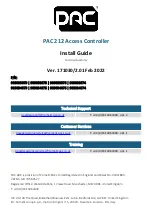
TC1796
Peripheral Units (Vol. 2 of 2)
Controller Area Network (MultiCAN) Controller
User’s Manual
22-149
V2.0, 2007-07
MultiCAN, V2.0
•
Another entry (except EOS) than an RME or a BCE has been found after the first
RME.
•
A reference message object is not valid when it is requested for transmission.
22.7.3
Synchronization Phase
When starting a TTCAN system (e.g. after reset), the entire system must be
synchronized after completing the configuration phase. During the synchronization
phase (indicated by bit field TTSR.SYNCS = 01
B
), the following actions must be taken
(or are taken automatically):
The Init_Watch_Trigger is taken into account until the first message is correctly received
or transmitted. An Init_Watch_Trigger event is detected when the cycle time reaches the
value of 2
16
-1. This event is indicated by IWTE = 1 and it only leads to an interrupt.
The watch trigger value given by the basic cycle end entry is taken into account only after
the first correct transfer of a message. When a watch trigger event occurs after
transferring a message correctly on the bus, the transmission and the reception of Data
Frames or Remote Frames are disabled (the CAN node is set to Configuration Mode).
During the synchronization phase, the scheduler entries RME or BCE with GM = 1 are
not taken into account.
22.7.4
Time Masters
22.7.4.1 State of a Time Master
A potential time master is a device that can transmit a reference message. A backup time
master is a potential time master that has received a reference message that was not its
own. The current time master is the device that has successfully sent its own reference
message. There is only one current time master in a TTCAN system.
If the current time master receives a reference message that is not its own, then it
becomes a backup time master. If a backup time master has successfully transmitted its
own reference message, it becomes the new current time master.
When a priority conflict between the TTCAN node and the actual time master is detected,
the value of RTO is automatically modified (decrement by 1). This means that the priority
of the actual time master (given by bits ID[2:0]) of the latest received reference message
is lower than the programmed TMPRIO value.
22.7.4.2 Strictly Time-Triggered Behavior
A strictly time-triggered behavior (gaps are not allowed) can be achieved if the scheduler
entries RME and BCE with GM = 0 are only used. In this case, the gap condition is
“ignored” for the transfer of a reference message. In order to avoid unintentional
















































